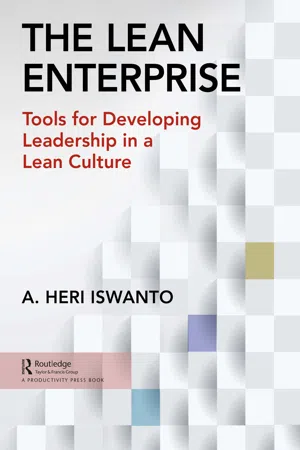
- 130 pages
- English
- ePUB (mobile friendly)
- Available on iOS & Android
About This Book
Lean culture should be developed so that the goal to improve a process or business condition on a continuous basis can be achieved. Organizations with a lean culture have reaped many successful experiences in implementing lean, so it is seen as a legitimate methodology for organizations. New employees coming into an organization that has a lean culture will be taught to see, think, and feel from a lean perspective in dealing with problems in their job.
Lean needs to be a cultural mindset for all for an organization to remain successful. The effort to build a lean culture relies on the support and active participation of leaders as the agents of change. Research shows that the success of a lean implementation is around 50% depending on leadership, while the remaining 30% is on finance, 10% on organization and culture, and 10% on skills and expert human resources. In general, leaders play a role in developing subordinates, problem-solving skills, and producing various continuous improvement efforts. In addition, leaders are responsible for encouraging subordinates to continuously use problem-solving tools as part of their efforts to improve their skills and deal with bigger problems.
This book focuses on leadership and the tools required to support a lean initiative. Understanding the basic and valuable tools of lean provides the foundation for leaders in support of their organization initiative. Topics in the book include a description of the eight wastes, organizational level process mapping, lean metrics, and developing a future position.
The author includes a discussion and samples of basic lean tools such as Kanban, standard work, and visual management. The author also describes the tools each leader needs to be successful with in creating a culture of lean thinking, including the leader task board, the process performance board, and process walk.
Frequently asked questions
Information
III
Developing Lean Culture
Chapter 10
Developing Lean Culture
a pattern of shared basic assumptions that have been learned when solving problems, which have worked well so that they can be considered as legitimate and hence, are being taught to new members as the proper way to see, think, and feel in relation to these problems.
Organizational Level | Primary Contribution | Task | Secondary Contribution | Task |
Strategic: senior (CEO, senior vice president) | Management; steering and oversight | Supporting cross-border perspective | Measurement; compliance to the process after project | Supervising cross-border indicators; Gemba |
Programmatic: function (vice president, director) | Accountability | Fulfilling project commitment; managing cross border performance | Compliance is disciplined; commitment to the process after project | Cooperating in process management; Gemba |
Tactical: department (manager, supervisor) | Tactical lean management system | Compliance is disciplined; Gemba | Colleagues involvement; continuous improvement | Educating, practicing problem solving from the root |
Table of contents
- Cover
- Half Title
- Title Page
- Copyright Page
- Dedication
- Table of Contents
- Acknowledgments
- Author
- Section I Establishing Current Position
- Section II Developing Future Position
- Section III Developing Lean Culture
- References
- Index